Mitigating Spatial Conflict of Land Use for Sustainable Wetlands Landscape in Li-Xia-River Region of Central Jiangsu, China
Abstract
1. Introduction
2. Methodology and Data
2.1. Study Area
2.2. Research Methods
2.2.1. Analytical Framework of Land Use Conflict
2.2.2. A Composite Index Model of Land Use Conflict
2.3. Data Synthesis and Processing
3. Results
3.1. Dynamic Changes of Landscape Pattern in Li-Xia-River Wetlands over the Last 40 Years
3.2. Characteristic Changes of Land Use Conflict from 1978 to 2018
3.3. Spatial Variation of Characteristics of Land Use Conflict
4. Discussion
4.1. Situation of Wetland Loss in Li-Xia-River Region in the Past 40 Years
4.2. Complex Influencing Factors of Land Use Spatial Conflict in Li-Xia-River Wetland
4.3. Uncertainty Analysis of Land Use Spatial Conflict and Expectation
5. Conclusions
Author Contributions
Funding
Institutional Review Board Statement
Informed Consent Statement
Data Availability Statement
Conflicts of Interest
References
- Gibbs, J.P. Wetland loss and biodiversity conservation. Conserv. Biol. 2000, 14, 314–317. [Google Scholar] [CrossRef]
- Trebitz, A.S.; Morrice, J.A.; Taylor, D.L.; Anderson, R.L.; West, C.W.; Kelly, J.R. Hydromorphic determinants of aquatic habitat variability in Lake Superior coastal wetlands. Wetlands 2005, 25, 505–519. [Google Scholar] [CrossRef]
- De Jong, L.; De Bruin, S.; Knoop, J.; van Vliet, J. Understanding land-use change conflict: A systematic review of case studies. J. Land Use Sci. 2021, 16, 223–239. [Google Scholar] [CrossRef]
- Costanza, R.; d’Arge, R.; de Groot, R.; Farber, S.; Grasso, M.; Hannon, B.; Limburg, K.; Naeem, S.; O’Neill, R.V.; Paruelo, J.; et al. The value of the world’s ecosystem services and natural capital. Nature 1997, 387, 253–260. [Google Scholar] [CrossRef]
- Kayranli, B.; Scholz, M.; Mustafa, A.; Hedmark, Å. Carbon Storage and Fluxes within Freshwater Wetlands: A Critical Review. Wetlands 2010, 30, 111–124. [Google Scholar] [CrossRef]
- Mukherjee, K.; Pal, S. Hydrological and landscape dynamics of floodplain wetlands of the Diara region, Eastern India. Ecol. Indic. 2021, 121, 106961. [Google Scholar] [CrossRef]
- Festus, O.O.; Ji, W.; Zubair, P.A. Characterizing the Landscape Structure of Urban Wetlands Using Terrain and Landscape Indices. Land 2020, 9, 29. [Google Scholar] [CrossRef]
- Hey, D.L.; Philippi, N.S. Flood reduction through wetland restoration: The upper Mississippi river basin as a case history. Restor. Ecol. 1995, 3, 4–17. [Google Scholar] [CrossRef]
- Zou, L.L.; Liu, Y.S.; Wang, J.Y.; Yang, Y.Y. An analysis of land use conflict potentials based on ecological-production-living function in the southeast coastal area of China. Ecol. Indic. 2021, 122, 107297. [Google Scholar] [CrossRef]
- Kelvin, J.; Acreman, M.C.; Harding, R.J.; Hess, T.M. Micro-climate influence on reference evapotranspiration estimates in wetlands. Hydrolog. Sci. 2017, 62, 378–388. [Google Scholar] [CrossRef][Green Version]
- Bunn, S.E.; Davies, P.M.; Mosisch, T.D. Ecosystem measures of river health and their response to riparian and catchment degradation. Freshwater Biol. 1999, 41, 333–345. [Google Scholar] [CrossRef]
- Tian, P.; Cao, L.D.; Li, J.L.; Pu, R.L.; Gong, H.B.; Li, C.D. Landscape Characteristics and Ecological Risk Assessment Based on Multi-Scenario Simulations: A Case Study of Yancheng Coastal Wetland, China. Sustainability 2021, 13, 149. [Google Scholar] [CrossRef]
- Samsó, R.; Garcia, J. BIO_PORE, a mathematical model to simulate biofilm growth and water quality improvement in porous media: Application and calibration for constructed wetlands. Ecol. Eng. 2013, 54, 116–127. [Google Scholar] [CrossRef]
- Jiang, S.; Meng, J.J.; Zhu, L.K. Spatial and temporal analyses of potential land use conflict under the constraints of water resources in the middle reaches of the Heihe River. Land Use Policy 2020, 97, 104773. [Google Scholar] [CrossRef]
- Jeng, H.; Hong, Y. Assessment of a natural wetland for use in wastewater remediation. Environ. Monit. Assess. 2005, 111, 113–131. [Google Scholar] [CrossRef]
- Guidolini, J.; Ometto, J.; Arcoverde, G.; Giarolla, A. Environmental Land Use Conflicts in a Macroscale River Basin: A Preliminary Study Based on the Ruggedness Number. Water 2020, 12, 1222. [Google Scholar] [CrossRef]
- Finlayson, M.; Cruz, R.D.; Davidson, N.; Alder, J.; Cork, S.; de Groot, R.S.; Lévêque, C.; Milton, G.R.; Peterson, G.; Pritchard, D.; et al. Millennium Ecosystem Assessment. Ecosystems and Human Well-Being: Wetlands and Water Synthesis; World Resources Institute: Washington, DC, USA, 2005. [Google Scholar]
- Richards, D.R.; Friessa, D.A. Rates and drivers of mangrove deforestation in Southeast Asia, 2000–2012. Proc. Natl. Acad. Sci. USA 2016, 113, 344–349. [Google Scholar] [CrossRef]
- Tao, S.; Fang, J.; Zhao, X.; Zhao, S.; Shen, H.; Hu, H.; Tang, Z.; Wang, Z.; Guo, Q. Rapid loss of lakes on the Mongolian Plateau. Proc. Natl. Acad. Sci. USA 2015, 112, 2281–2286. [Google Scholar] [CrossRef]
- Treat, C.C.; Wollheim, W.M.; Varner, R.K.; Grandy, A.S.; Talbot, J.; Frolking, S. Temperature and peat type control CO2 and CH4 production in Alaskan permafrost peats. Glob. Chang. Biol. 2014, 20, 2674–2686. [Google Scholar] [CrossRef]
- McCauley, L.A.; Jenkins, D.G.; Quintana-Ascencio, P.F. Isolated wetland loss and degradation over two decades in an increasingly urbanized landscape. Wetlands 2013, 33, 117–127. [Google Scholar] [CrossRef]
- Sica, Y.V.; Quintana, R.D.; Radeloff, V.C.; Gavier-Pizarro, G.I. Wetland loss due to land use change in the Lower Paraná River Delta, Argentina. Sci. Total Environ. 2016, 568, 867–978. [Google Scholar] [CrossRef]
- Ahani, S.; Dadashpoor, H. Land conflict management measures in peri-urban areas: A meta-synthesis review. J. Environ. Plan. Manag. 2021, 64, 1909–1939. [Google Scholar] [CrossRef]
- Fang, C.; Liu, H. The spatial privation and the corresponding controlling paths in China’s urbanization process. Acta Geogr. Sin. Chin. Ed. 2007, 62, 67–78. [Google Scholar]
- Campbell, D.J.; Gichohi, H.; Mwangi, A.; Chege, L. Land use conflict in Kajiado district, Kenya. Land Use Policy 2000, 17, 337–348. [Google Scholar] [CrossRef]
- Brown, G.; Raymond, C.M. Methods for identifying land use conflict potential using participatory mapping. Landsc. Urban Plan. 2014, 122, 196–208. [Google Scholar] [CrossRef]
- Jing, W.L.; Yu, K.H.; Wu, L.; Luo, P.P. Potential Land Use Conflict Identification Based on Improved Multi-Objective Suitability Evaluation. Remote Sens. 2021, 13, 2416. [Google Scholar] [CrossRef]
- Kristina, D.; Bettina, E. Analysing land conflicts in times of global crises. Geoforum 2020, 111, 208–217. [Google Scholar]
- Schnaiberg, J.; Riera, J.; Turner, M.G.; Voss, P.R. Explaining human settlement patterns in a recreational lake district: Vilas County, Wisconsin, USA. J. Environ. Manag. 2002, 30, 24–34. [Google Scholar] [CrossRef]
- Zedler, J.B.; Kercher, S. Wetland resources: Status, trends, ecosystem services and restorability. Annu. Rev. Envrion. Resour. 2005, 30, 39–74. [Google Scholar] [CrossRef]
- Yang, M.; Gong, J.G.; Zhao, Y.; Wang, H.; Zhao, C.P.; Yang, Q.; Yin, Y.S.; Wang, Y.; Tian, B. Landscape Pattern Evolution Processes of Wetlands and Their Driving Factors in the Xiong’an New Area of China. Int. J. Environ. Res. Public Health 2021, 18, 4403. [Google Scholar] [CrossRef]
- Zhang, X.J.; Wang, G.Q.; Xue, B.L.; Zhang, M.X.; Tan, Z.X. Dynamic landscapes and the driving forces in the Yellow River Delta wetland region in the past four decades. Sci. Total Environ. 2021, 787, 147644. [Google Scholar] [CrossRef]
- Lu, Q.; Kang, L.; Shao, H.; Zhao, Z.; Chen, Q.; Bi, X.; Shi, P. Investigating marsh sediment dynamics and its driving factors in Yellow River delta for wetland restoration. Ecol. Eng. 2016, 90, 307–313. [Google Scholar] [CrossRef]
- Zeng, X.T.; Huang, G.H.; Yang, X.L.; Wang, X.; Fu, H.; Li, Y.P.; Li, Z. A developed fuzzy-stochastic optimization for coordinating human activity and eco-environmental protection in a regional wetland ecosystem under uncertainties. Ecol. Eng. 2016, 97, 207–230. [Google Scholar] [CrossRef]
- Ma, W.Q.; Jiang, G.G.; Chen, Y.H.; Qu, Y.B.; Zhou, T.; Li, W.Q. How feasible is regional integration for reconciling land use conflicts across the urban–rural interface? Evidence from Beijing–Tianjin–Hebei metropolitan region in China. Land Use Policy 2020, 92, 104433. [Google Scholar] [CrossRef]
- Davidson, N.C.; Finlayson, C.M. Earth observation for wetland inventory, assessment and monitoring. Aquat. Conserv. Mar. Freshw. Ecosyst. 2007, 17, 219–228. [Google Scholar] [CrossRef]
- Brown, G.; Fagerholm, N. Empirical PPGIS/PGIS mapping of ecosystem services: A review and evaluation. Ecosyst. Serv. 2015, 13, 119–133. [Google Scholar] [CrossRef]
- Qin, P.; Zhang, Z.H. Evolution of wetland landscape disturbance in Jiaozhou Gulf between 1973 and 2018 based on remote sensing. Eur. J. Remote Sens. 2021, 54, 145–154. [Google Scholar] [CrossRef]
- Chan, K.K.Y.; Xu, B. Perspective on remote sensing change detection of Poyang Lake wetland. Ann. GIS 2013, 19, 231–243. [Google Scholar] [CrossRef]
- Scott, D.A.; Jones, T.A. Classification and inventory of wetlands: A global overview. Vegetatio 1995, 118, 3–16. [Google Scholar] [CrossRef]
- Lehner, B.; Döll, P. Development and validation of a global database of lakes, reservoirs and wetlands. J. Hydrol. 2004, 296, 1–22. [Google Scholar] [CrossRef]
- Gong, P.; Wang, J.; Yu, L.; Zhao, Y.; Zhao, Y.; Liang, L.; Niu, Z.; Huang, X.; Fu, H.; Liu, S.; et al. Finer resolution observation and monitoring of global land cover: First mapping results with Landsat TM and ETM+ data. Int. J. Remote Sens. 2013, 34, 2607–2654. [Google Scholar] [CrossRef]
- Davidson, N.C. How much wetland has the world lost? Long-term and recent trends in global wetland area. Mar. Freshw. Res. 2014, 65, 934–941. [Google Scholar] [CrossRef]
- Heffernan, J.B.; Soranno, P.A.; Angilletta Jr, M.J.; Buckley, L.B.; Gruner, D.S.; Keitt, T.H.; Kellner, J.R.; Kominoski, J.S.; Rocha, A.V.; Xiao, J.; et al. Macrosystems ecology: Understanding ecological patterns and processes at continental scales. Front. Ecol. Environ. 2014, 12, 5–14. [Google Scholar] [CrossRef]
- Susman, R.; Gütte, A.M.; Weith, T. Drivers of Land Use Conflicts in Infrastructural Mega Projects in Coastal Areas: A Case Study of Patimban Seaport, Indonesia. Land 2021, 10, 615. [Google Scholar] [CrossRef]
- Kuang, W.; Liu, J.; Dong, J.; Chi, W.; Zhang, C. The rapid and massive urban and industrial land expansions in China between 1990 and 2010: A CLUD-based analysis of their trajectories, patterns, and drivers. Landsc. Urban Plan. 2016, 145, 21–33. [Google Scholar] [CrossRef]
- Niu, Z.; Zhang, H.; Wang, X.; Yao, W.; Zhou, D.; Zhao, K.; Zhao, H.; Li, N.; Huang, H.; Li, C.; et al. Mapping wetland changes in China between 1978 and 2008. Chin. Sci. Bull. 2013, 57, 2813–2823. [Google Scholar] [CrossRef]
- An, S.; Li, H.; Guan, B.; Zhou, C.; Wang, Z.; Deng, Z.; Zhi, Y.; Liu, Y.; Xu, C.; Fang, S.; et al. China’s natural wetlands: Past problems, current status, and future challenges. AMBIO J. Hum. Environ. 2007, 36, 335–342. [Google Scholar] [CrossRef]
- Xu, C.; Sheng, S.; Zhou, W.; Cui, L.; Liu, M. Characterizing wetland change at landscape scale in Jiangsu Province, China. Environ. Monit. Assess. 2011, 179, 279–292. [Google Scholar] [CrossRef]
- Cui, L.L.; Li, G.S.; Chen, Y.H.; Li, L.G. Response of Landscape Evolution to Human Disturbances in the Coastal Wetlands in Northern Jiangsu Province, China. Remote Sens. 2021, 13, 2030. [Google Scholar] [CrossRef]
- Cui, J.X.; Kong, X.S.; Chen, J.; Sun, J.W.; Zhu, Y.Y. Spatially Explicit Evaluation and Driving Factor Identification of Land Use Conflict in Yangtze River Economic Belt. Land 2021, 10, 43. [Google Scholar] [CrossRef]
- Bossuyt, F.; Meegaskumbura, M.; Beenaerts, N.; Gower, D.J.; Pethiyagoda, R.; Roelants, K.; Mannaert, A.; Wilkinson, M.; Bahir, M.M.; Manamendra-Arachchi, K.; et al. Local endemism within the Western Ghats-Sri Lanka biodiversity hotspot. Science 2004, 306, 479–481. [Google Scholar] [CrossRef]
- Nelson, T.A.; Boots, B. Detecting spatial hot spots in landscape ecology. Ecography 2008, 31, 556–566. [Google Scholar] [CrossRef]
- Herold, M.; Goldstein, N.C.; Clarke, K.C. The spatiotemporal form of urban growth: Measurement, analysis and modeling. Remote Sens. Environ. 2003, 86, 286–302. [Google Scholar] [CrossRef]
- Jiangsu Forestry Bureau. Report of Wetland Inventory of Jiangsu Province. Jiangsu Forestry Bureau. Available online: http://lyj.jiangsu.gov.cn/art/2010/3/22/art_7147_3003201.html. (accessed on 22 March 2010).
- Gao, Y.; Wang, J.M.; Zhang, M.; Li, S.J. Measurement and prediction of land use conflict in an opencast mining area. Resour. Policy 2021, 71, 101999. [Google Scholar] [CrossRef]
- Hargis, C.D.; Bissonette, J.A.; David, J.L. The behavior of landscape metrics commonly used in the study of habitat fragmentation. Landsc. Ecol. 1998, 13, 167–186. [Google Scholar] [CrossRef]
- Aronson, J.; Clewell, A.; Moreno-Mateos, D. Ecological restoration and ecological engineering: Complementary or indivisible? Ecol. Eng. 2016, 91, 392–395. [Google Scholar] [CrossRef]
- Sheng, S.; Xu, C.; Zhang, S.; An, S.; Liu, M.; Yang, X. Hot spots of wetland vegetation reduction in relation to human accessibility: Differentiating human impacts on natural ecosystems at multiple scales. Environ. Earth Sci. 2012, 65, 1965–1975. [Google Scholar] [CrossRef]
- Cong, P.F.; Chen, K.X.; Qu, L.M.; Han, J.B.; Yang, Z.X. Determination of landscape ecological network of wetlands in the Yellow river delta. Wetlands 2020, 40, 2729–2739. [Google Scholar] [CrossRef]
- Guo, H.G.; Cai, Y.P.; Yang, Z.F.; Zhu, Z.C.; Ouyang, Y.R. Dynamic simulation of coastal wetlands for Guangdong-Hong Kong-Macao Greater Bay area based on multi-temporal Landsat images and FLUS model. Ecol. Indic. 2021, 125, 107559. [Google Scholar] [CrossRef]
- Huang, D.P.; Liu, C.; Fang, H.J.; Peng, S.F. Assessment of waterlogging risk in LiXiahe region of Jiangsu Province based on AVHRR and MODIS image. Chin. Geogr. Sci. 2008, 18, 178–183. [Google Scholar] [CrossRef][Green Version]
- Ling, S. Study on changes of sheyang lake in historical periods. J. Lake Sci. 1993, 5, 225–233. [Google Scholar]
- Obery, A.M.; Landis, W.G. A regional multiple stressor risk assessment of the Codorus creek watershed applying the relative risk model. Hum. Ecol. Risk Assess. 2002, 8, 405–428. [Google Scholar] [CrossRef]
- Serveiss, V.B. Applying ecological risk principles to watershed assessment and management. Environ. Manag. 2002, 29, 145–154. [Google Scholar] [CrossRef]
- Peng, J.; Zhou, G.; Tang, C.; He, Y. The analysis of spatial conflict measurement in fast urbanization region based on ecological security: A case study of Changsha-Zhuzhou-Xiangtan urban. J. Nat. Resour. 2012, 27, 1507–1519. [Google Scholar]
- Peterseil, J.; Wrbka, T.; Plutzar, C.; Schmitzberger, I.; Kiss, A.; Szerencsits, E.; Reiter, K.; Schneider, W.; Suppan, F.; Beissmann, H. Evaluating the ecological sustainability of Austrian agricultural landscapes—The SINUS approach. Land Use Policy 2004, 21, 307–320. [Google Scholar] [CrossRef]
- Swanström, N.L.P.; Weissmann, M. Conflict, Conflict Prevention, Conflict Management and Beyond: A Conceptual Exploration; Central Asia-Caucasus Institute & Silk Road Studies Program: Washington, DC, USA, 2005. [Google Scholar]
- Barnaud, C.; Page, C.L.; Dumrongrojwatthana, P.; Trébuil, G. Spatial representations are not neutral: Lessons from a participatory agent-based modelling process in a land-use conflict. Environ. Modell. Softw. 2013, 45, 150–159. [Google Scholar] [CrossRef]
- Dai, X.; Zhou, Y.; Ma, W.; Zhou, L. Influence of spatial variation in land-use patterns and topography on water quality of the rivers inflowing to Fuxian Lake, a large deep lake in the plateau of southwestern China. Ecol. Eng. 2017, 99, 417–428. [Google Scholar] [CrossRef]
- NSBC. China Statistical Yearbook. National Bureau of Statistics of China. Available online: http://www.stats.gov.cn/tjsj/ndsj/2016/indexch.htm (accessed on 1 September 2021).
- Chen, W.; Sun, W.; Zhao, H. The spatial imbalanced pattern and state assessment of regional development. Acta Geogr. Sin. 2010, 65, 1209–1217. [Google Scholar]
- Zhou, D.; Xu, J.; Lin, Z. Conflict or coordination? Assessing land use multi-functionalization using production-living-ecology analysis. Sci. Total Environ. 2017, 577, 136–147. [Google Scholar] [CrossRef]
- Batty, M. The Size, Scale, and Shape of Cities. Science 2008, 319, 769–771. [Google Scholar] [CrossRef]
- Zhang, Z.; Zhao, W.; Gu, X. Changes resulting from a land consolidation project (LCP) and its resource–environment effects: A case study in Tianmen City of Hubei Province, China. Land Use Policy 2014, 40, 74–82. [Google Scholar] [CrossRef]
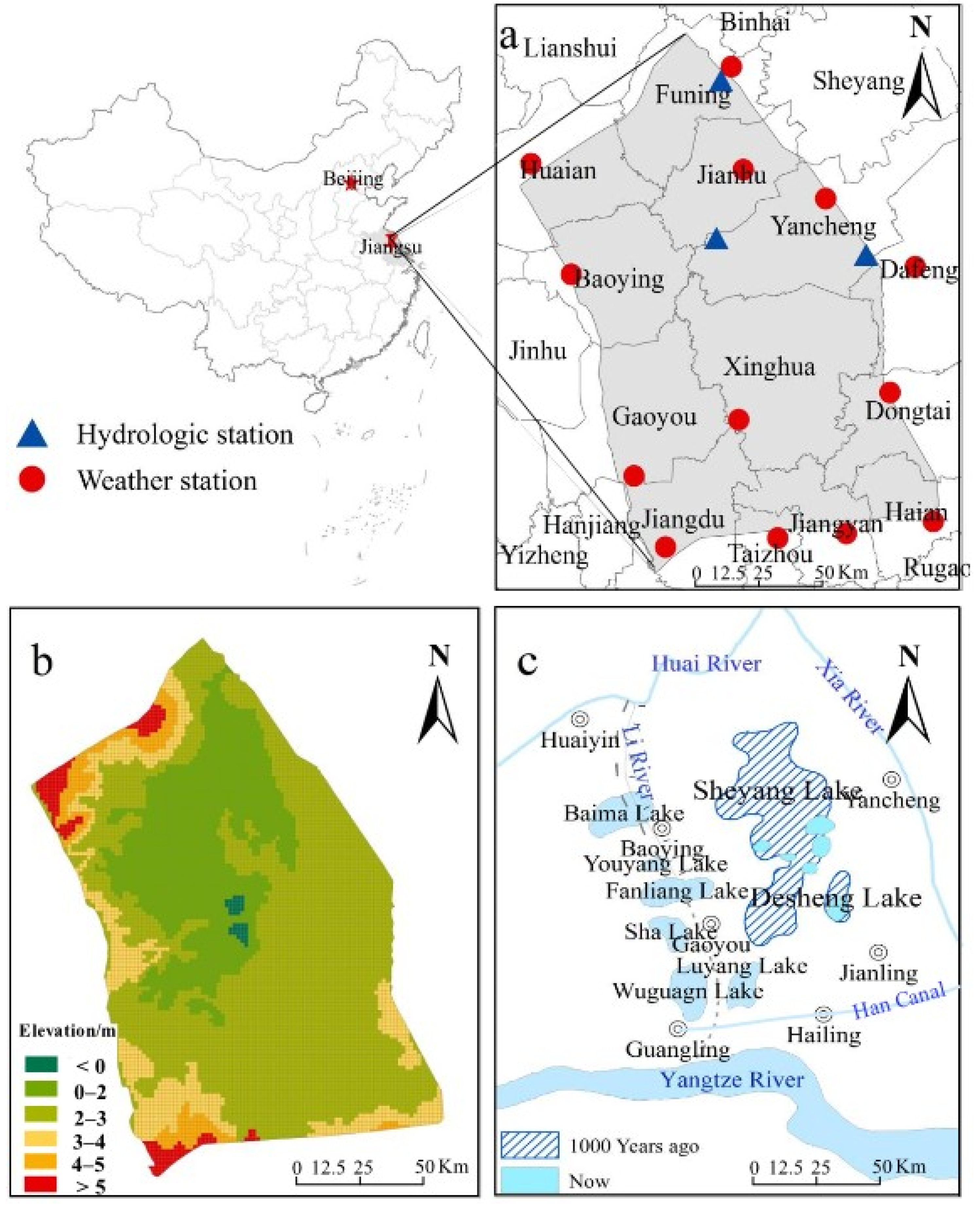
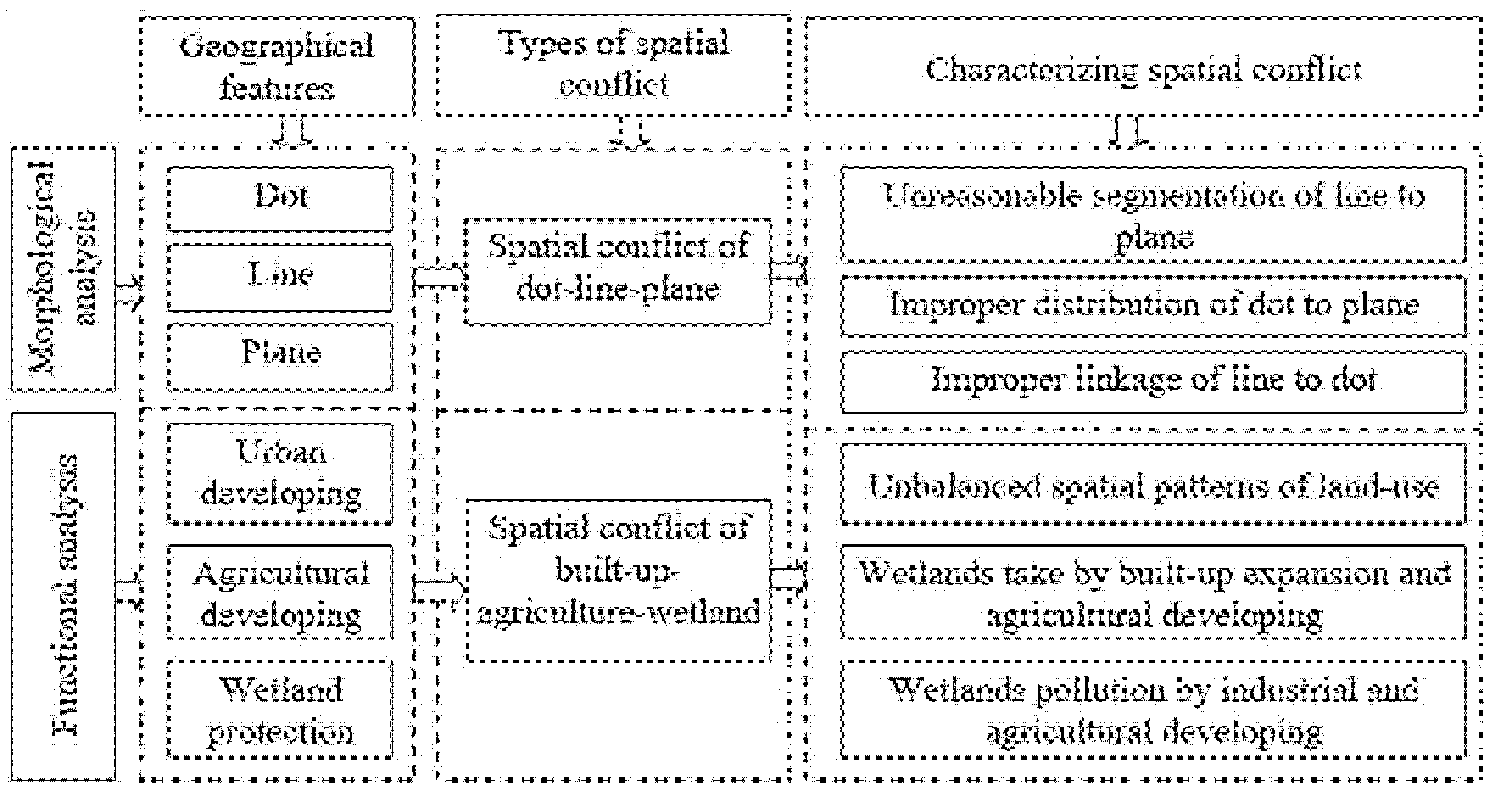
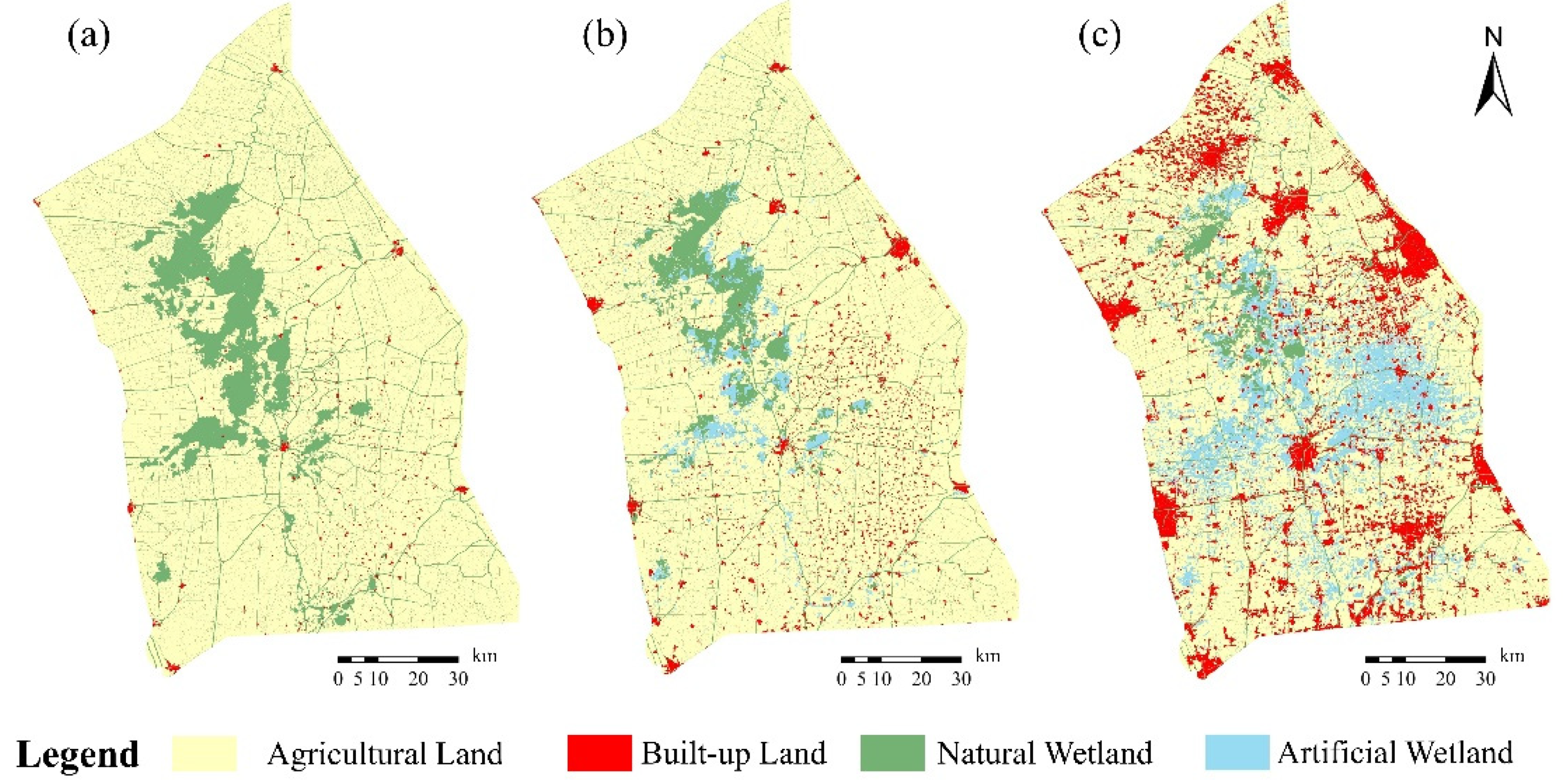

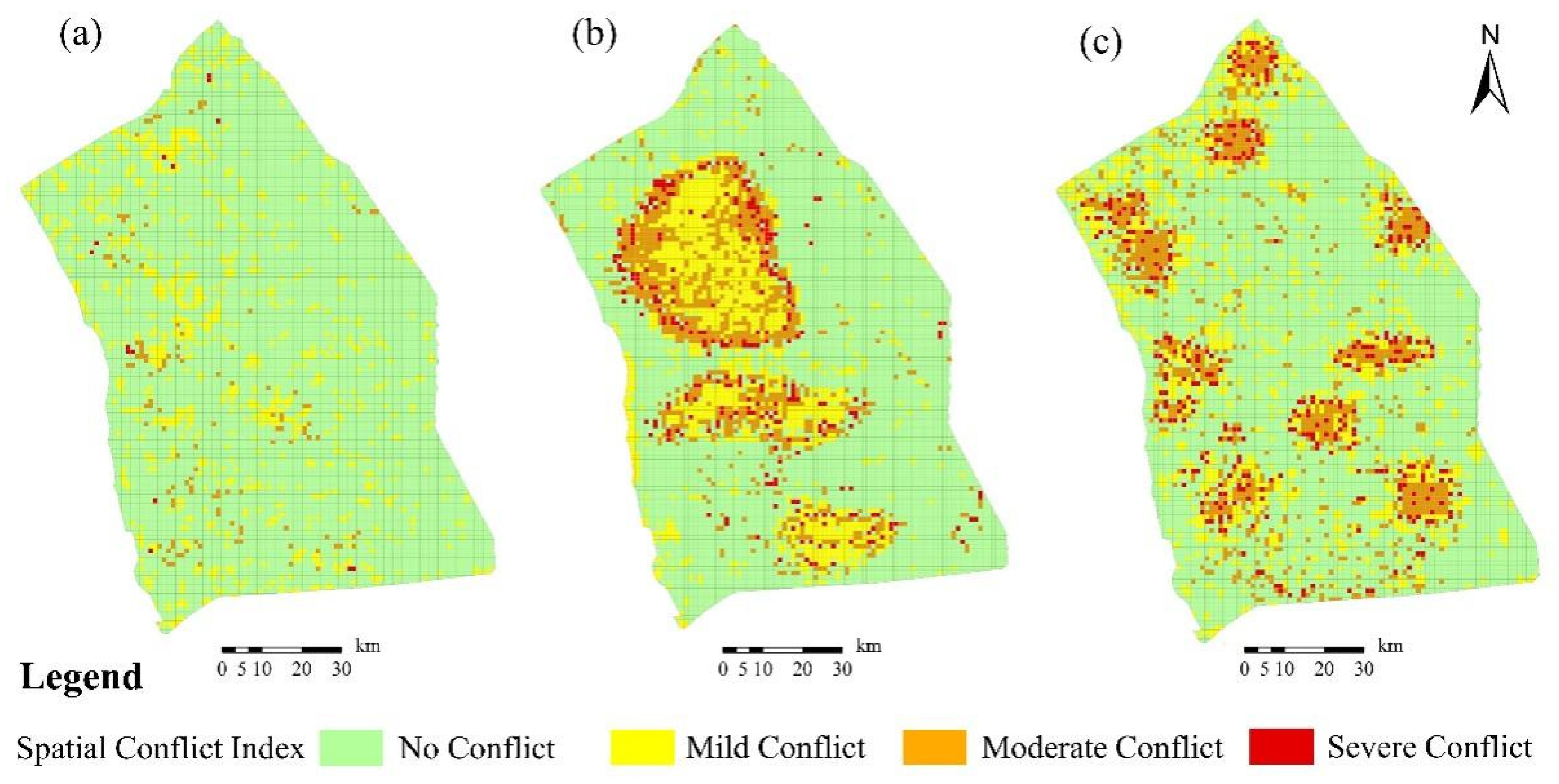
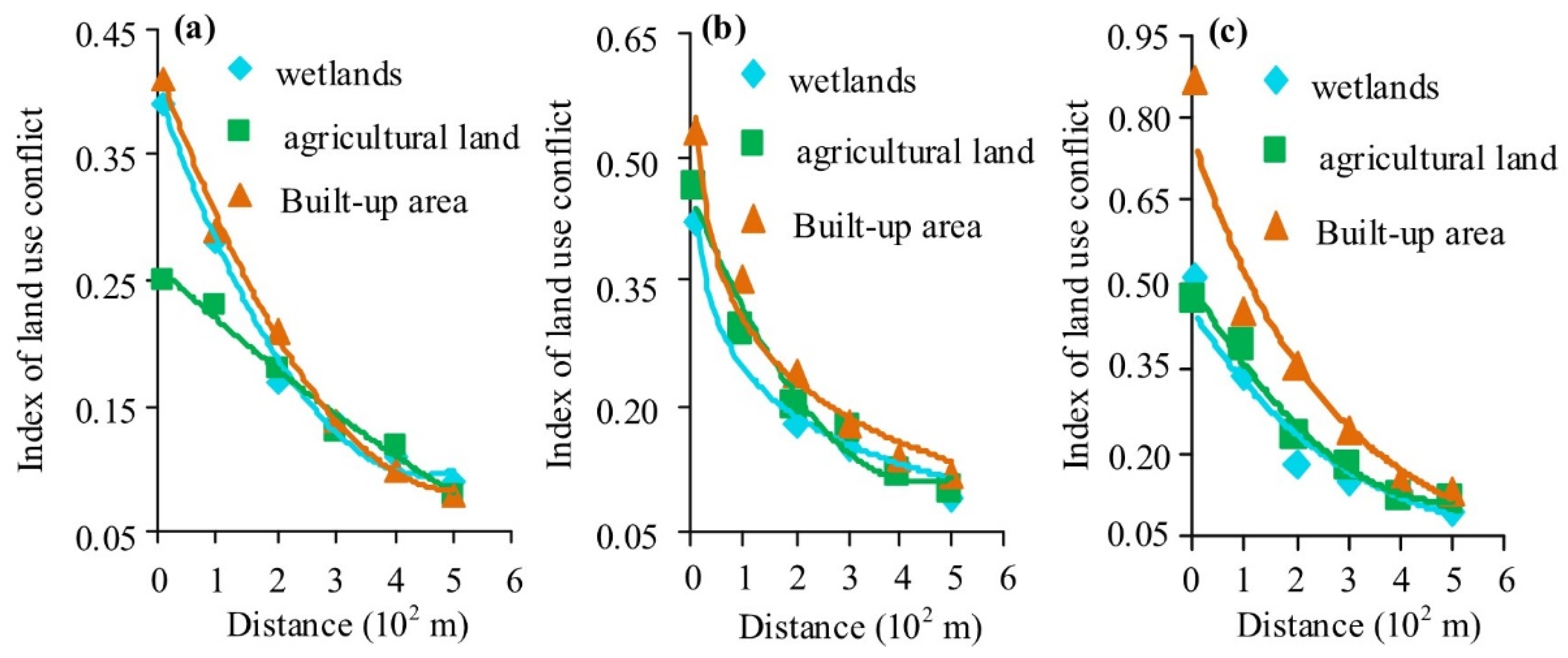
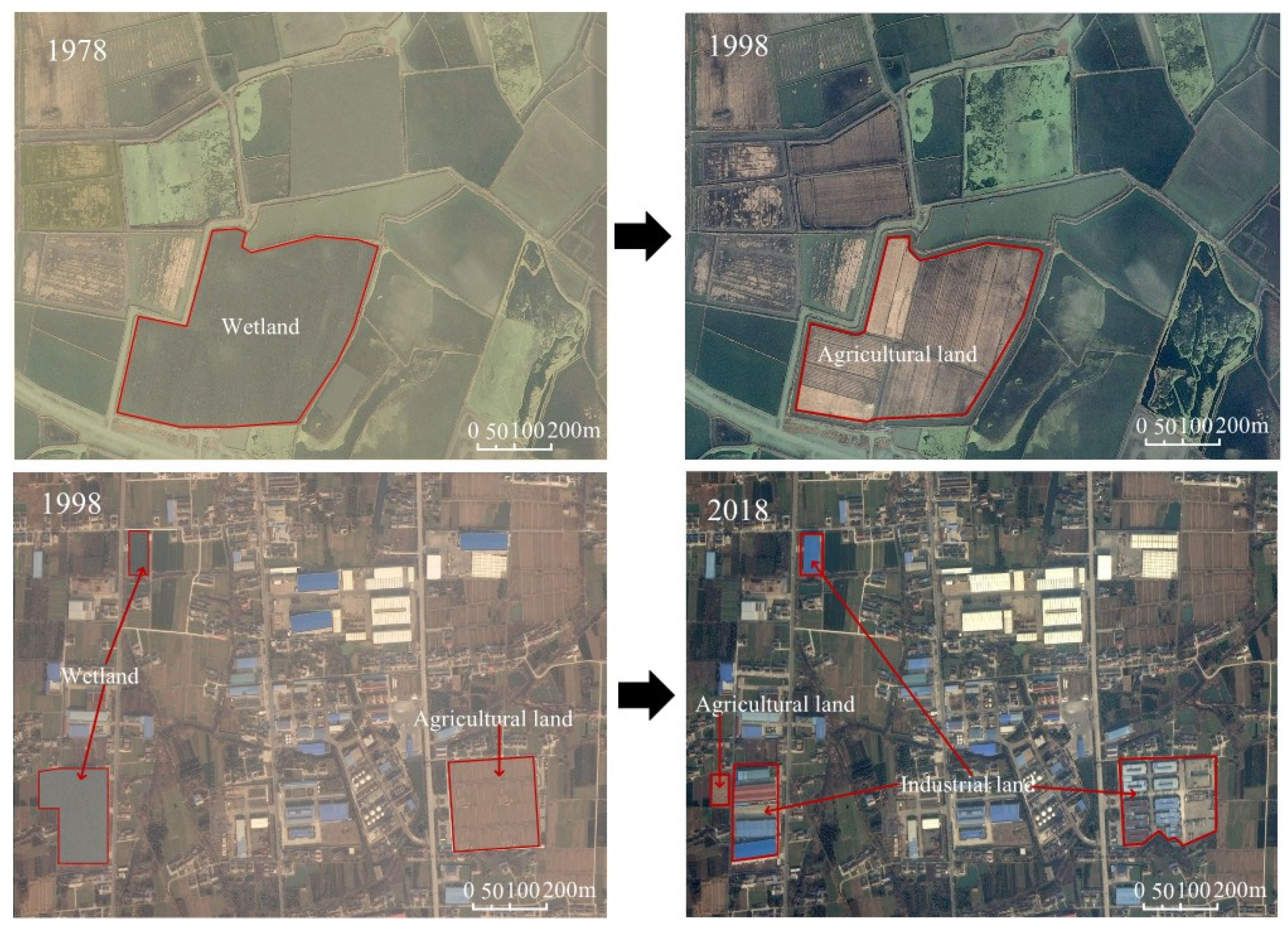
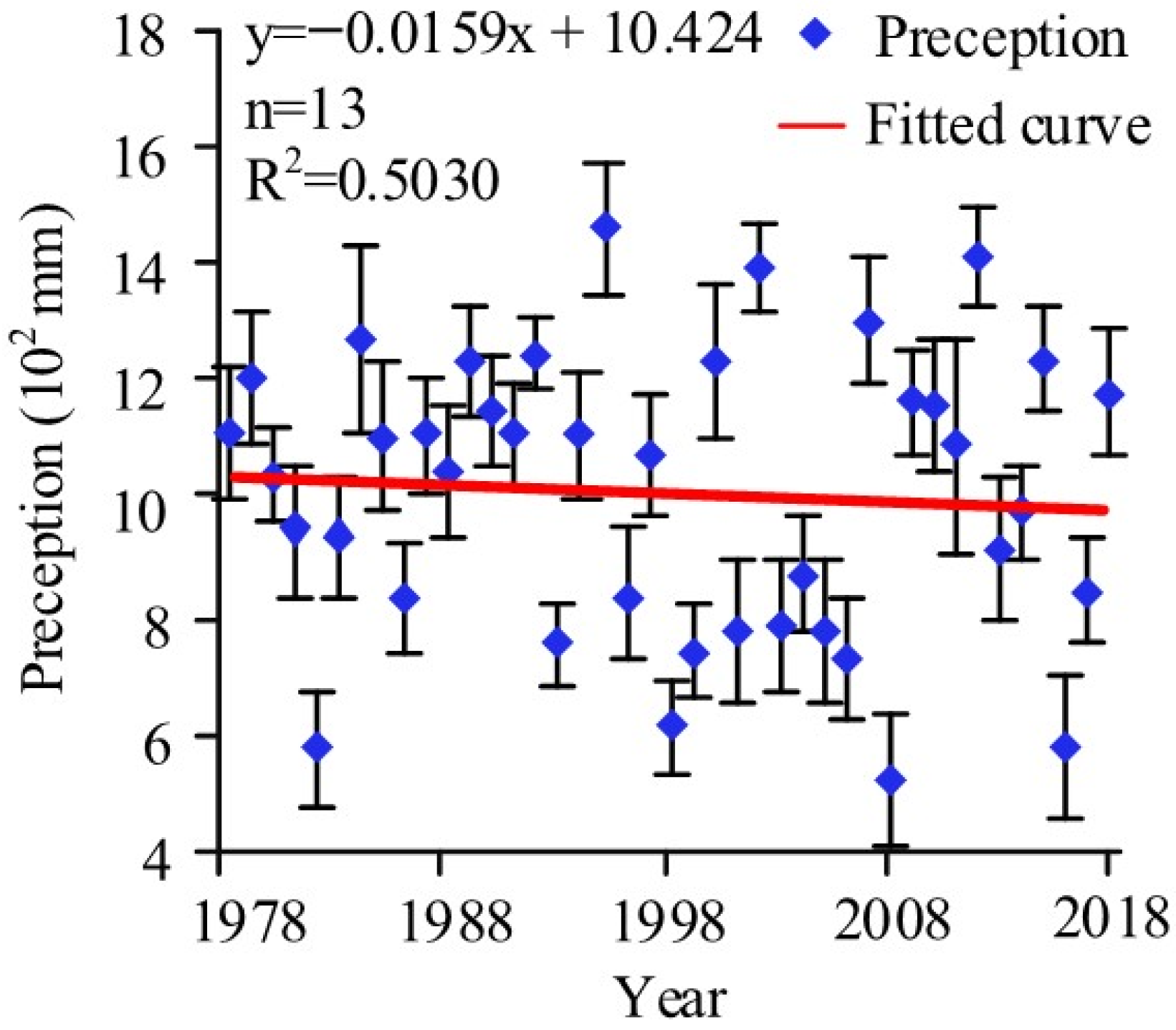
| Date of Imaging | Stripe Number (Path/Row) | Sensor Type | Resolution (m) |
|---|---|---|---|
| 1978-07-05, 1978-09-16 | 128/37, 129/37 | Landsat MSS | 79 |
| 1998-05-30, 1998-07-26 | 120/37, 119/37 | Landsat TM | 30 |
| 2018-08-02, 2018-10-12 | 119/37, 120/37 | Landsat OLI | 30 |
| Value Range of EUs | 1978 | 1998 | 2018 | Level of Conflict | |||
|---|---|---|---|---|---|---|---|
| Number | % | Number | % | Number | % | ||
| 0–0.30 | 10,038 | 88.34 | 8532 | 73.52 | 8170 | 71.90 | No conflict |
| 0.30–0.60 | 1161 | 10.22 | 1339 | 15.50 | 1593 | 14.02 | Mild conflict |
| 0.60–0.85 | 147 | 1.29 | 1144 | 9.30 | 1170 | 10.30 | Moderate conflict |
| 0.85–1.0 | 17 | 0.15 | 348 | 1.68 | 430 | 3.78 | Severe conflict |
| Average | 0.15 | 0.26 | 0.35 | ||||
| Sum | 11,363 | 100 | 11,363 | 100 | 11,363 | 100 | |
Publisher’s Note: MDPI stays neutral with regard to jurisdictional claims in published maps and institutional affiliations. |
© 2021 by the authors. Licensee MDPI, Basel, Switzerland. This article is an open access article distributed under the terms and conditions of the Creative Commons Attribution (CC BY) license (https://creativecommons.org/licenses/by/4.0/).
Share and Cite
Sun, Y.; Ge, X.; Liu, J.; Chang, Y.; Liu, G.-J.; Chen, F. Mitigating Spatial Conflict of Land Use for Sustainable Wetlands Landscape in Li-Xia-River Region of Central Jiangsu, China. Sustainability 2021, 13, 11189. https://doi.org/10.3390/su132011189
Sun Y, Ge X, Liu J, Chang Y, Liu G-J, Chen F. Mitigating Spatial Conflict of Land Use for Sustainable Wetlands Landscape in Li-Xia-River Region of Central Jiangsu, China. Sustainability. 2021; 13(20):11189. https://doi.org/10.3390/su132011189
Chicago/Turabian StyleSun, Yan, Xiaoping Ge, Junna Liu, Yuanyuan Chang, Gang-Jun Liu, and Fu Chen. 2021. "Mitigating Spatial Conflict of Land Use for Sustainable Wetlands Landscape in Li-Xia-River Region of Central Jiangsu, China" Sustainability 13, no. 20: 11189. https://doi.org/10.3390/su132011189
APA StyleSun, Y., Ge, X., Liu, J., Chang, Y., Liu, G.-J., & Chen, F. (2021). Mitigating Spatial Conflict of Land Use for Sustainable Wetlands Landscape in Li-Xia-River Region of Central Jiangsu, China. Sustainability, 13(20), 11189. https://doi.org/10.3390/su132011189






